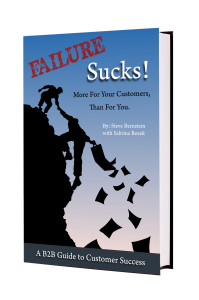Search Waypoint Resources
Misled by SaaS Customer Success Metrics?

Dear VP of Customer Success:
I am writing to you as a friend.
I am in the B2B business myself. After decades of working alongside business-to-business (B2B) companies to help them understand customer needs and prioritize action, I started my own company. So I understand the need for software-as-a-service (SaaS) Customer Success and the complications associated with having a pulse on everything that’s going on in your organization.
But I also feel the need to let you in on a secret: If your company is spending money on “Customer Success” (CS) solutions, you are probably being taken advantage of.
Because the CS vendors have it all wrong.
Here’s why:
You’ll find that they focus on collecting data based on customer adoption of your products. Then they bestow the moniker of “customer success” on this spurious data.
 It’s largely nonsense – instead of “Customer Success” a better name would be “Vendor Success” since the vendor is the primary benefiting party, not the customer. The more your products are used by your customers, the more money you, the vendor, usually makes.
It’s largely nonsense – instead of “Customer Success” a better name would be “Vendor Success” since the vendor is the primary benefiting party, not the customer. The more your products are used by your customers, the more money you, the vendor, usually makes.
The really distressing part is that despite the name, usage/adoption gives you zero information about whether your customers are actually being successful. Simply because a customer spends time in your product, doesn’t mean they accomplished what they needed or expected to. So while high usage might imply success, it’s certainly not the same as success. Not that “Vendor Success” isn’t important, but it’s different than Customer Success, don’t you think?
There is a way, however, SaaS vendors could measure how successful their customers truly are. They just don’t.
An example of a client that was tired of being fed the industry-accepted paradigms is Intacct. They understood the conventional approach was faulty, so they created a holistic program that listened to customers and nicely used adoption.
Watch the Intacct team discuss their own journey here.
A responsible vendor that truly understands the combined power of Word-of-Mouth and Customer Success would help their customers properly identify the people that are responsible for assessing success – probably a group of budget holders, program and project managers, power users, and other key influencers – and then engage them to understand how they measure and perceive their success. In other words, define the Buying Committee and know their expected outcomes. Only then could this dream vendor understand how that “customer” measures and perceives success. I bet your current vendor isn’t doing that.
 Tip from your ol’ buddy, Steve: I’ll bet the sales rep that originally sold the deal would know if there is a definition of success and what it was. If the sales rep didn’t find out when the deal was sold, then do yourself a favor…fire him or her. You can thank me later. The only hitch is it’s entirely possible that the committee that bought may no longer be in the same role. It doesn’t take a brain surgeon to figure out that the new people in play probably have different definitions of success. There’s also a chance they got the job, because the person before them either didn’t have a sound definition for success or couldn’t meet said goal.
Tip from your ol’ buddy, Steve: I’ll bet the sales rep that originally sold the deal would know if there is a definition of success and what it was. If the sales rep didn’t find out when the deal was sold, then do yourself a favor…fire him or her. You can thank me later. The only hitch is it’s entirely possible that the committee that bought may no longer be in the same role. It doesn’t take a brain surgeon to figure out that the new people in play probably have different definitions of success. There’s also a chance they got the job, because the person before them either didn’t have a sound definition for success or couldn’t meet said goal.
Once this Buying Committee is identified, our hero vendor would ask those people to what extent they are realizing success. You know, COMMUNICATE. Engage.
This vendor could also ask these “success measurers” if and how they perceive value (this is a close second to success.)

Want to learn more about how to drive a customer-centric culture? Click the image to check out Failure Sucks
They would put a plan in place with the customer to address gaps between current success and desired success (btw, this is often where there is an opportunity for upselling and cross-selling).
B2B is about a thousand times more about relationships than B2C is. Which is why you really need to achieve a more (much more) accurate method of defining customer success. Otherwise improving it is as easy as teaching an elephant to walk a tightrope.
Once you implement a better way of measuring success, use it to identify your happiest customers. Your Sales and Marketing teams will be ever so grateful to be able to enlist their help with references and referrals. And we would certainly hope that those are the top spending clients, i.e. those with high adoption of a full portfolio of your products and services (if not, get selling!). Then, find out why they’re adopting your solution and what are you doing right by them. This is the part your current vendor is probably not doing for you. Once you have this information, apply this learning to other customers. Your relationships with clients – and the associated benefits from having true Advocates – will improve exponentially.
Anyway, I just wanted to let you know in the event you are being taken for a “CS” ride. That’s information I figured you’d like to know.
Love Always,
Steve